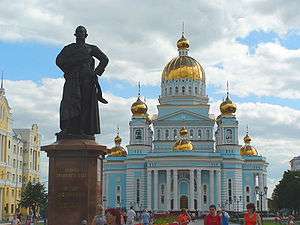Fyodor Ushakov
| Fyodor Ushakov | |
|---|---|
 Fyodor Fyodorovich Ushakov | |
| Native name | Фёдор Фёдорович Ушако́в |
| Birth name | Fyodor Fyodorovich Ushakov |
| Born |
24 February 1745 Burnakovo, Yaroslavl Oblast, Russian Empire |
| Died |
14 October 1817 (aged 72) Alekseevka, Tambov Governorate, Russian Empire |
| Allegiance |
|
| Service/branch |
|
| Years of service | 1766–1812 |
| Rank | Admiral |
| Battles/wars | |
| Awards | |
Fyodor Fyodorovich Ushakov (Russian: Фёдор Фёдорович Ушако́в) (February 24, 1745, Burnakovo – October 14, 1817, Tambov Governorate) was the most illustrious Russian naval commander and admiral of the 18th century.
Life and naval career
Ushakov was born in the village of Burnakovo in the Yaroslavl gubernia, to a modest family of the minor nobility. On February 15, 1761, he signed up for the Russian Navy in Saint Petersburg. After training, he served on a galley in the Baltic Fleet. In 1768 he was transferred to the Don Flotilla (Azov Sea Navy) in Taganrog, and served in the Russo-Turkish War (1768–74). He commanded Catherine II's own yacht, and later defended Russian merchant ships in the Mediterranean from British Royal Navy attacks.
After the Russian Empire annexed Crimea in 1783, Ushakov personally supervised the construction of a naval base in Sevastopol and the building of docks in Kherson. During the Russo-Turkish War (1787–92), he brilliantly defeated the Turks at Fidonisi (1788), Kerch Strait (1790), Tendra (1790), and Cape Kaliakra (1791). In these battles, he demonstrated the excellence of his innovative doctrines in the art of naval fighting.
In 1798 Ushakov was promoted to full admiral and given command of a squadron which sailed to the Mediterranean via Constantinople, where it joined with a Turkish squadron. The Russian-Turkish fleet then operated under Ushakov's command in the War of the Second Coalition against France. The expedition started by conquering the Ionian islands, acquired by France the year before from the defunct Republic of Venice in the Treaty of Campo Formio. This action culminated in the siege of Corfu (1798-1799), and led to the subsequent creation of the Republic of Seven Islands. Ushakov's squadron then blockaded French bases in Italy, notably Genoa and Ancona, and successfully assaulted Naples and Rome.
Tsar Paul, in his capacity as the Grand Master of the Order of St. John, ordered Ushakov to proceed to Malta, which a British fleet under Nelson had besieged to no effect.
Ushakov was senior in rank to Nelson, and Nelson would be subordinate to him. Nelson disliked that very much, and therefore suggested dispatching the Russian squadron to Egypt instead.

Brewing conflict between the commanders was prevented by Ushakov's being recalled to Russia in 1800, where the new Emperor, Alexander I, failed to appreciate his victories. Ushakov resigned command in 1807 and withdrew into the Sanaksar Abbey in modern-day Mordovia. He was asked to command the local militia during the Patriotic War of 1812 but declined.
In the course of 43 naval battles under his command he did not lose a single ship and never lost a battle.
Tactics
Distinguishing features of Ushakov's tactics were: use of unified marching and fighting orders; resolute rapprochement with the enemy forces at a short distance without evolution of a fighting order; a concentration of the basic efforts against flagships of the enemy; reserve allocation (Kaiser-flag squadrons); combination of aimed artillery fire and maneuvering; and chasing the enemy up to its full destruction or capture. Giving great value to sea and fire training of staff, Ushakov was a supporter of generalissimo Suvorov's principles of training for sailors and officers. Ushakov's innovations were among the first successful developments of naval tactics, from its "line" to maneuvering concepts.
Legacy

Several warships have been named after Admiral Ushakov.
On March 3, 1944 the Presidium of the Supreme Soviet of the USSR established the Order of Ushakov for Navy officers who showed outstanding achievement leading to victory over a numerically superior enemy. This medal was one of several which was preserved in Russia upon the dissolution of the Soviet Union, thus remaining one of the highest military awards in the Russian Federation. The Ushakov Medal was established simultaneously for servicemen who had risked their life in naval theatres defending the Soviet Union. In May 2014, the medal was presented to 19 surviving British sailors who had served on the Arctic convoys during World War II in a ceremony aboard HMS Belfast.[1]
The Baltic Naval Institute in Kaliningrad also carries his name. The minor planet 3010 Ushakov, discovered by Soviet astronomer Lyudmila Ivanovna Chernykh in 1978, is named after him.[2]
In 1953 two Soviet films were released portraying his career Attack from the Sea and Admiral Ushakov. In both films he was played by Ivan Pereverzev.
Canonization
The Russian Orthodox Church glorified him as a patron saint of the Russian Navy in 2000. His relics are preserved in Sanaksar Monastery. He was also declared the patron saint of Russian nuclear-armed strategic bombers in 2005 by Patriarch Alexius II in the Cathedral of St. Theodore Ushakov.
References
- ↑ John Naughton (22 May 2014). "Arctic Convoy veterans honoured by Russia on HMS Belfast". Daily Telegraph. Retrieved 23 May 2014.
- ↑ Dictionary of Minor Planet Names - p.247
External links
- M. Romm movie (IMDb)
- English biography
- The Naval Art of Admiral Fyodor F. Ushakov
- Ushakov's battleship St Paul
- (Святой морской дьявол) (The holy sea-devil), an article in Kommersant-Dengi (in Russian), available online
- Baltic Naval Institute named after F.F. Ushakov
- Sanaksar Monastery - Official site (Russian)
- Sanaksar Monastery - Photo gallery (Russian) (English)